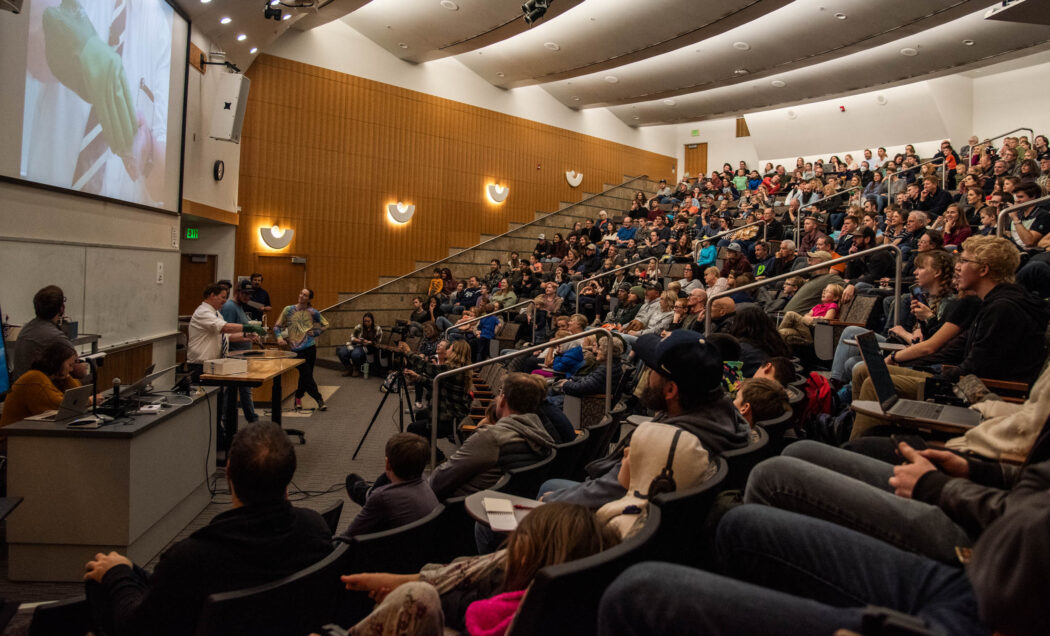Annual physics November demo inducts electricity, entertainment
For some, the last week of school before Thanksgiving means planning trips, buying food and getting as much homework done as possible. For others, it means it’s time for the Physics November Demo Show.
James Coburn, the demonstration specialists for the Department of Physics at USU, put on the first demo show 16 years ago.
“I wanted to share physics demonstrations with the public,” Coburn said. “I like it when people learn something new and when they see something that they think is really cool.”
Coburn said he was inspired by the Christmas Lectures at the Royal Institution in London, England, a physics show which has been going on for almost 200 years.
“Since our students are gone at Christmas, I decided to do it here at Thanksgiving time,” Coburn said.
Maryanna Wendel, Coburn’s daughter, has been helping with the demo shows since the beginning.
“The November demo show is a free event to help get the public excited about physics,” Wendel said. “My dad has an amazing way of making it fun.”
The demo show attracts between 300 and 500 people each year, despite the weather. Coburn said he loves hearing from the different people who come to the show.
“I met a woman a couple of weeks ago,” Coburn said. “She said, ‘Hey, you’re the demo guy. We come to your show every year. It’s a tradition now.’”
Wendel said her favorite part of helping is watching the audience’s reaction to the demos.
“Even if I’ve seen a demo 100 times, there’s something so magical about seeing someone else see it for the first time,” Wendel said.
This year, the theme for the demo show was electromagnetic induction.
“Every year on the night of the demo show I go home, and that evening I pick the topic for the next year,” Coburn said.
So, what is electromagnetic induction?
In “Faraday’s Law of Induction,” Britannica defines it as the measurable relationship showing that a changing magnetic field can create a current in a circuit.
It was discovered by Michael Faraday in 1831 when he attached a conducting wire to a device to measure the circuit’s voltage.
Faraday found that a current was produced when a moving conductor was placed in a stationary magnetic field, or a stationary conductor was placed in a moving magnetic field.
As he continued experimenting, Faraday was able to determine what setups garnered the most electromagnetic induction.
For example, the more a wire is coiled around a device, the greater the voltage. Also, the faster the magnetic field is changing increases the voltage as well.
According to Britannica, in “Faraday’s Law of Induction,” other principles, such as Lenz’s law, Biot-Savart law and Ampere’s law have all gone on to influence electromagnetic induction as we know it today.
According to Wendel, physics is sometimes seen as boring, or inapplicable to everyday life.
“Physics kind of tends to get a bad rap,” Wendel said.
However, electromagnetic induction is the foundation behind many technologies people use.
AC and electric generators work on the basis of electromagnetic induction. The wireless power transfer seen in devices like cell phones uses this principle as well.
Furthermore, computer hard drives operate on electromagnetic induction, and the future of vehicles uses these physics laws to advance hybrid and electric options.
With the importance of electromagnetic induction in mind, Coburn felt confident in his choice of theme for this year’s demo show.
“I spent a year researching, planning, building and buying demos,” Coburn said. “I get a lot of help during the demo show and sometimes with building new demos.”
According to Coburn, a lot of this help comes from his family, like Wendel.
“My family helps me present the show,” Coburn said. “I like that it’s a family event. Lots of families come.”
Wendel said she’s continued helping Coburn with the show because she enjoys hearing about his passion while he presents.
“Isn’t it kind of fun to hear someone talk about something passionately?” Wendel said. “And I really never get tired of the demos myself.”
Coburn said the demo show continues because of its popularity.
“I think the students like to see physics come to life,” Coburn said. “To see things that they’ve learned about actually happen.”
It’s not just USU students and the Cache Valley community that loves the demo show. Coburn said he really enjoys the work he does for the demonstration each year.
“Physics is a search for the fundamental answers of how everything works,” Coburn said. “I like to know how things work, and I like to share that with others.”
For more information about the Physics November Demo Show and the past demonstrations, visit usu.edu/science/events/physics-november-demo-show.
“See you next year,” Coburn said. “The Friday before Thanksgiving.”

